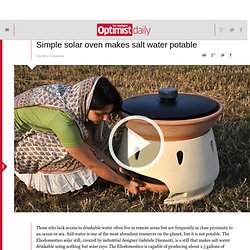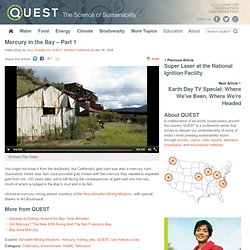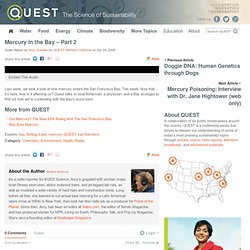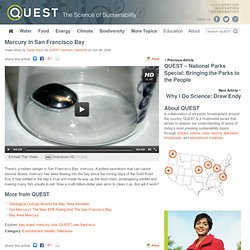

The Optimist Daily. Those who lack access to drinkable water often live in remote areas but are frequently in close proximity to an ocean or sea.

Salt water is one of the most abundant resources on the planet, but it is not potable. The Eliodomestico solar still, created by industrial designer Gabriele Diamanti, is a still that makes salt water drinkable using nothing but solar rays. The Eliodomestico is capable of producing about 1.3 gallons of water a day. RiverWeb Water Quality Simulator. Sea Turtle Restoration Project : Got Mercury? California's Deadlocked Delta: Is Carbon Farming the Future? This is the third story in our three-part series on California's Delta.

Tules on Twitchell Island in the Delta. (Photo: Josh Cassidy/KQED) With thousands of acres of rich farmland, the Delta has a long agricultural legacy. But farming there can be a risky business. Dozens of farms have been flooded over the past half century as aging levees have collapsed. That became a reality for farmer Rudy Mussi on the morning of June 3, 2004. Mussi was growing corn and asparagus on lower Jones Tract, an island in the Delta, 10 miles west of Stockton. "Your heart stops for a second or two and then realism sets in. How did a flood happen a on a sunny day? "Once a break occurs, you know, there's no way you're gonna stop that, not with 10 feet of water on the other side," Mussi says. The levee break on Jones Tract in 2004. It wasn't an isolated incident. Delta Infrastructure at Risk Levee-building began in the 1850s, when settlers came to the Delta for the rich soil.
Farming Carbon Related. Mercury in the Bay – Part 1. You might not know it from the textbooks, but California's gold rush was also a mercury rush.

Quicksilver mines near San Jose provided gold miners with the mercury they needed to separate gold from ore. 150 years later, we're still facing the consequences of gold-rush era mercury, much of which is lodged in the Bay's mud and in its fish. Historical mercury mining photos courtesy of the New Almaden Mining Museum, with special thanks to Art Boudreault. Explore: Almaden Mining Museum, mercury, mining, pbs, QUEST, san francisco bay Category: Chemistry, Environment, Health, Television About the Author (Author Archive) As a radio reporter for KQED Science, Amy's grappled with archaic maps, brain fitness exercises, albino redwood trees, and jet-lagged lab rats, as well as modeled a wide variety of hard hats and construction vests. Mercury in the Bay – Part 2. Last week, we took a look at how mercury enters the San Francisco Bay.

This week: Now that it's here, how is it affecting us? Quest talks to local fisherman, a physician, and a Bay ecologist to find out how we're contending with the Bay's worst toxin. Explore: bay, fishing, kqed, mercury, QUEST, san francisco Category: Chemistry, Environment, Health, Radio About the Author (Author Archive) As a radio reporter for KQED Science, Amy's grappled with archaic maps, brain fitness exercises, albino redwood trees, and jet-lagged lab rats, as well as modeled a wide variety of hard hats and construction vests. Mercury in San Francisco Bay. There's a hidden danger in San Francisco Bay: mercury.

A potent neurotoxin that can cause serious illness, mercury has been flowing into the bay since the mining days of the Gold Rush Era. It has settled in the bay's mud and made its way up the food chain, endangering wildlife and making many fish unsafe to eat. Now a multi-billion-dollar plan aims to clean it up. But will it work?